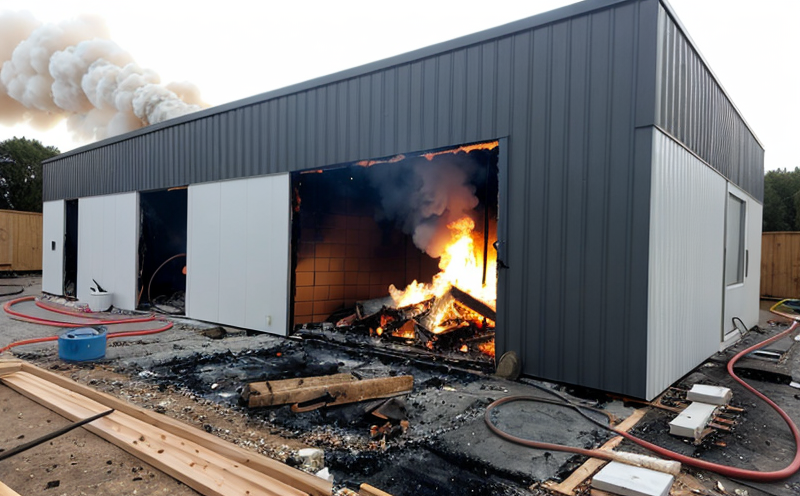Fire Resistance of Wood-Based Cladding
The fire resistance testing of wood-based cladding is a critical aspect in ensuring building safety and compliance with international standards. Wood-based cladding, commonly used in construction to provide weather protection and aesthetics, can also pose significant fire risks if not properly tested and specified.
Fire resistance testing assesses the ability of a material or system to withstand exposure to fire without collapsing or compromising the structural integrity of the building. This is particularly important for wood-based cladding which, despite its excellent insulation properties, can be susceptible to rapid combustion under certain conditions. The primary aim is to determine how long the cladding can resist ignition and continue to provide a barrier against the spread of fire.
The testing process involves subjecting specimens to controlled environments that mimic real-world fire scenarios. This includes exposure to temperatures as high as 1000°C, sustained for up to several hours. During this period, the cladding is monitored for its ability to prevent the passage of flame and smoke, maintain structural integrity, and resist collapse.
According to ISO standards such as ISO 6797:2015 "Plastics - Determination of resistance to propagation of combustion in horizontal specimens," similar methodologies are followed. The testing setup includes a furnace with a defined heating profile that simulates the fire conditions encountered during an actual blaze.
The process begins by preparing the cladding samples according to specified dimensions and thicknesses as outlined in the standard. These samples are then mounted vertically into the test rig, ensuring they align correctly for accurate testing. Once positioned, the furnace is heated up to reach the required temperature, typically over a period of 20 minutes.
During the test, detailed data on heat release rates, smoke production, and flame spread is collected using specialized instrumentation. This information helps in evaluating not only the fire resistance but also the overall performance of the cladding under extreme conditions. The testing continues until one or more predetermined criteria are met, such as the collapse of the specimen or the failure to maintain a protective layer.
The results of these tests are crucial for architects and engineers when specifying materials for new builds or retrofits. They provide essential information on the fire performance of wood-based cladding, enabling informed decisions that enhance safety standards in construction projects.
Scope and Methodology
The scope of our fire resistance testing for wood-based cladding is comprehensive. It includes a detailed examination of the material's ability to resist ignition and spread of fire, ensuring it meets stringent safety standards.
The methodology involves several key steps:
- Sample preparation according to ISO 6797:2015
- Mounting specimens in a controlled furnace environment
- Monitoring temperature and flame spread using advanced sensors
- Data collection on heat release rates, smoke production, and other relevant parameters
| Parameter | Description | Unit of Measurement |
|---|---|---|
| Heat Release Rate (HRR) | The rate at which the material releases heat during combustion. | kW/m² |
| Smoke Production | The amount of smoke produced by the material when exposed to fire. | % |
| Flame Spread Index (FSI) | An indicator of how quickly flames spread along the surface of the cladding. | - |
Benefits
The benefits of fire resistance testing for wood-based cladding extend beyond mere compliance with regulations. They offer significant advantages in terms of enhanced safety, improved design flexibility, and cost-effective solutions.
Firstly, fire resistance testing ensures that the cladding meets stringent international standards such as ISO 6797:2015. This not only provides peace of mind to developers but also helps in avoiding potential legal issues related to non-compliance.
Secondly, by ensuring fire resistance, architects and engineers can make informed choices that balance aesthetics with safety. This allows for more creative designs without compromising on the vital aspect of fire safety.
Thirdly, fire-resistant cladding contributes to reducing insurance premiums as it is considered a safer option for buildings. Insurance providers often offer premium discounts for properties equipped with fire-resistant materials.
Lastly, compliance with testing and certification standards can lead to better market access and improved brand reputation. It demonstrates the commitment of businesses to high-quality products that meet safety expectations.
Industry Applications
| Application | Description |
|---|---|
| New Construction Projects | Ensuring compliance with building codes and enhancing safety in residential, commercial, and industrial buildings. |
| Retrofitting Existing Buildings | Upgrading fire safety standards of older structures without compromising on aesthetics or functionality. |
| Sustainable Building Design | Integrating environmentally friendly materials that also meet high fire resistance standards. |





